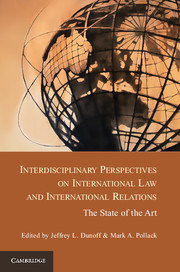 Interdisciplinary Perspectives on International Law and International Relations
Interdisciplinary Perspectives on International Law and International Relations Book contents
- Frontmatter
- Contents
- Contributors
- Acknowledgments
- Part I Introduction: Setting the Stage
- Part II Theorizing International Law
- Part III Making International Law
- Part IV The Interpretation and Application of International Law
- 14 The Multiple Roles of International Courts and Tribunals
- 15 The Design of Dispute Settlement Procedures in International Agreements
- 16 Whose Agents? The Interpretation of International Law in National Courts
- 17 International Judicial Independence
- 18 The Politics of Treaty Interpretation
- Part V Enforcement, Compliance, and Effectiveness
- Conclusions
- Index
- References
18 - The Politics of Treaty Interpretation
Variations and Explanations across International Tribunals
Published online by Cambridge University Press: 05 January 2013
- Frontmatter
- Contents
- Contributors
- Acknowledgments
- Part I Introduction: Setting the Stage
- Part II Theorizing International Law
- Part III Making International Law
- Part IV The Interpretation and Application of International Law
- 14 The Multiple Roles of International Courts and Tribunals
- 15 The Design of Dispute Settlement Procedures in International Agreements
- 16 Whose Agents? The Interpretation of International Law in National Courts
- 17 International Judicial Independence
- 18 The Politics of Treaty Interpretation
- Part V Enforcement, Compliance, and Effectiveness
- Conclusions
- Index
- References
Summary
International tribunals rely on interpretation of legal texts as a crucial tool in adjudication. What is puzzling is the wide variation we observe in treaty interpretation by international tribunals across policy areas and over time. The international relations (IR) literature has largely overlooked the factors that explain the extent and scope of treaty interpretation. Although there is an extensive normative literature in international law (IL) as to the right way to interpret, empirical work still lacks mid-range theories to account for the observed variance of behavior across international tribunals. This chapter tries to fill this gap by providing a conceptual toolkit inspired by IL and IR theories to approach the various types of interpretation (interpretation choices) and underlying explanations (demand-side interpretation space and supply-side interpretation incentives).
In IL scholarship, attention has focused on the normative question of how treaties should be interpreted, especially with reference to the Vienna Convention on the Law of Treaties (VCLT) referring, in turn, to text, context, object and purpose, and preparatory works of a treaty (Gardiner 2008; Van Damme 2009). These Vienna Convention rules apply, in principle, to all international tribunals, irrespective of their institutional setup, subject matter, or geographical scope. Divergence between international tribunals in the practical application of these rules of treaty interpretation has been pointed out (Weiler 2010). Yet, categorizing where exactly international tribunals have diverged in their approach and, especially, thinking about what factors might explain these differences, has received little or no attention. Instead, divergence has been labeled as an incorrect application of the Vienna Convention rules or proof that these rules are outdated or should not fully apply to a particular tribunal (Klabbers 2010: 33). This chapter leaves the normative issue aside and focuses on the descriptive and conceptual aspects: what is it that international tribunals actually do, and how could this behavior be explained, first, within the same tribunal operating over time and, second, across tribunals operating in different contexts or regimes?
- Type
- Chapter
- Information
- Interdisciplinary Perspectives on International Law and International RelationsThe State of the Art, pp. 445 - 474Publisher: Cambridge University PressPrint publication year: 2012
References
- 13
- Cited by


